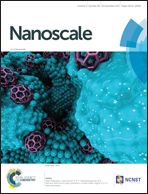Nanochannels as molecular check valves†
Abstract
A molecular check valve is a nanomachine that enables unidirectional molecular transport. In this work, we report a novel molecular check valve fabricated by asymmetric modification of a silica nanoporous membrane (SNM) consisting of parallel nanochannels with a diameter of 2–3 nm. Asymmetric modification refers to the thermal deposition of hydrophobic polydimethylsiloxane (PDMS) only on one side of the SNM to generate hydrophobic nanoorifices. Such an asymmetric nanostructure, designated as PDMS-SNM, could synergistically exert a hydrophobic force on the molecules by PDMS nanoorifices and an electrostatic force by naked silica nanochannels, resulting in unidirectional molecular transport under specific circumstances. Typically, only positively charged molecules were able to transport across the PDMS-SNM from the PDMS nanoorifice side, while backward transport from the other side was prohibited. In the former case, positively charged molecules were subject to electrostatic attraction from naked silica channels, which could exceed the hydrophobic rejection from PDMS nanoorifices to pull the molecule across the PDMS-SNM. However, in the latter case the electrostatic attraction is no longer a driving force to overcome the hydrophobic rejection from PDMS nanoorifices to promote the molecular transport. On the other hand, the PDMS-SNM based molecular check valve can be shut down to prevent any molecular transport from either side of the PDMS-SNM under certain conditions, such as a high salt concentration or an appropriate pH (e.g., pH 3). We believe that it could be applied to convert natural fluctuation energy into directed motion, as well as to prevent backward transport in batteries and fuel cells.



 Please wait while we load your content...
Please wait while we load your content...